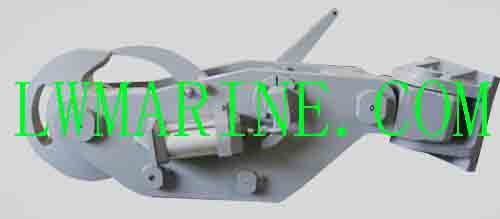Introduction to Marine Release Hooks
Marine release hooks (or disconnecting hooks) are specialized safety devices designed for controlled load release in maritime operations. These critical load-handling components enable rapid disconnection of cables, ropes, and chains during towing, mooring, lifting, and emergency situations. Modern release hooks incorporate fail-safe mechanisms that prevent accidental opening while allowing intentional release under load when required.
Types of Marine Release Hooks
1. Manual Release Hooks
- Basic mechanical designs
- Operation: Lever or pin-activated
- Applications:
- Small boat davits
- Auxiliary lifting operations
- Temporary mooring systems
- Safety factor: 5:1 minimum breaking load
2. Remote-Controlled Release Hooks
- Electro-hydraulic activation
- Features:
- Bridge-operated systems
- Load monitoring sensors
- Dual activation circuits
- Typical uses:
- Offshore supply vessels
- Dynamic positioning systems
- Heavy lift operations
3. Emergency Quick-Release Hooks
- Designed for rapid disconnection
- Activation methods:
- Hydraulic pressure release
- Pyrotechnic cutting devices
- Magnetic release systems
- Critical applications:
- Lifeboat release systems
- Towing emergency disconnect
- Storm mooring release
4. Specialized Hook Designs
| Type | Unique Feature | Application |
|---|---|---|
| Rotating Hooks | 360° swivel capability | Crane operations |
| Twin-Lock Hooks | Dual safety catches | Personnel lifts |
| Load-Monitoring Hooks | Integrated strain gauges | Heavy offshore lifts |
| Corrosion-Resistant Hooks | Titanium construction | Saltwater environments |
Marine Release Hooks Technical Specifications
Performance Standards
- Working Load Limit (WLL): 1-500 metric tons
- Safety Factor: 4:1 to 6:1 (depending on class)
- Release Time: <5 seconds for emergency models
- Operating Temperature: -30°C to +60°C
Material Composition
- Hook Body: Forged alloy steel (Grade 100)
- Pins: Stainless steel (316L marine grade)
- Bearings: Self-lubricating bronze
- Coatings: Hot-dip galvanizing or marine epoxy
Marine Release Hooks Safety Mechanisms
Fail-Safe Features
- Double-Locking Systems: Primary and secondary locks
- Load-Activated Locking: Automatic engagement under tension
- Anti-Vibration Design: Prevents unintended release
- Position Sensors: Hook status indicators on bridge
SOLAS Compliance Requirements
- Lifeboat Hooks: MSC.1/Circ.1392 standards
- Load Testing: 2.2× WLL proof load
- Materials Certification: EN 10204 3.1
- Corrosion Resistance: 5,000 hour salt spray test
Marine Release Hooks Maintenance & Inspection
Monthly Checks
- Visual inspection: Cracks/deformation
- Lubrication: Pivot points and bearings
- Function test: Manual release operation
- Corrosion assessment: Coating integrity
Annual Certification
- Non-Destructive Testing: MPI or UT inspection
- Load Testing: 1.5× WLL operational test
- Calibration: Load cells (if equipped)
- Documentation: Class society surveys
Marine Release Hooks Common Failure Modes
| Failure Type | Root Cause | Preventive Action |
|---|---|---|
| Jammed mechanism | Salt crystallization | Freshwater rinsing |
| Corrosion pitting | Coating failure | Cathodic protection |
| Fatigue cracks | Cyclic loading | Regular MPI inspection |
| False locked position | Wear in safety latch | Dimensional checks |
Marine Release Hooks Industry Standards
Classification Society Rules
- ABS: 4-3-2/5.11 (Lifting Appliances)
- DNVGL: ST-0378 (Offshore Hooks)
- Lloyd’s Register: Code for Lifting Appliances
International Regulations
- IMO MSC.1/Circ.1392: Lifeboat Release Systems
- ISO 2415: Shipbuilding – Eye Plates and Hooks
- OCIMF MEG4: Mooring Equipment Guidelines
Selection Guide
| Application | Recommended Type | Key Feature |
|---|---|---|
| Lifeboat Systems | SOLAS-compliant quick release | Dual redundant activation |
| Offshore Lifting | Rotating load-monitoring hook | 360° rotation + telemetry |
| Harbor Tugs | Remote-controlled tow release | Hydraulic fail-safe |
| Deck Cranes | Twin-lock rotating hook | Anti-sway design |
Emerging Technologies
- Smart Hooks: IoT-enabled load monitoring
- Composite Materials: Carbon fiber reinforced hooks
- Laser Release Systems: Non-contact disconnection
- Biometric Activation: Crew authentication for release
Conclusion
Marine release hooks represent critical safety interfaces where proper selection, operation, and maintenance directly impact maritime safety. Understanding hook types, release mechanisms, and inspection protocols helps prevent catastrophic failures during critical operations. As marine operations become more complex, release hook technology continues evolving with smarter monitoring systems and more reliable disconnection methods to meet stringent safety requirements.
SEO Keywords: Marine release hook, quick release hook, SOLAS hooks, lifeboat release system, emergency disconnect hook, offshore lifting hooks, towing release hook, hook safety mechanisms, marine hook standards, load monitoring hook, fail-safe hooks, shipboard disconnecting systems.
